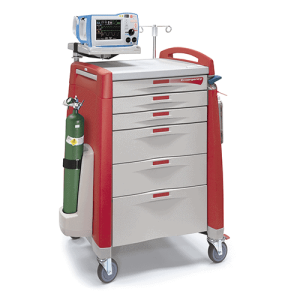 There is so much more to a superior crash cart/emergency cart than just its physical design. In fact, as evidenced by a 2016 thorough analysis, a crash cart’s blend of careful design, functionality, and logical organization can have an effect – negative or positive – on patient safety and code response time.
There is so much more to a superior crash cart/emergency cart than just its physical design. In fact, as evidenced by a 2016 thorough analysis, a crash cart’s blend of careful design, functionality, and logical organization can have an effect – negative or positive – on patient safety and code response time.
Boston Medical Center was using 25-year-old crash carts, accumulated from several different facilities that had been merged over time. The carts were different in height, appearance, access and maneuverability. They were in constant need of repair and no longer met workflow needs.
Boston Medical Center initiated a quality improvement project in 2016 to identify common issues with its current carts and to evaluate design solutions for standardizing new crash carts, with a focus on usability and patient safety.
A Code Committee was established with members that included nurses, physicians, pharmacists, respiratory therapists, purchasing, and administrators. The Code Committee’s survey of the nursing staff uncovered three main challenges: cluttered carts, difficulty locating stock, and inconsistent cart access.
The Code Committee identified and tested two different crash carts: one metal and one HDPE plastic.
The last factor – user-friendly design – was the strongest consideration. Users had to quickly and easily identify critical medications and supplies. Placement of accessories and ample workspace had to provide an ergonomic workspace and improve workflow. Cart height, weight, and movement had to accommodate nurses. Lastly, cart security was tested to ensure medications were secure, but quickly accessible for timely code response.
Following the Code Committee’s cart evaluation and the nurse testing, Boston Medical Center chose the Avalo Crash Cart from Capsa Healthcare.
Boston Medical Center used the Avalo Series integrated divider system to re-organize their medication and patient supplies drawer by drawer. Stock was analyzed; some items were removed, and others added. Stock positions were tested and finalized, and “best practices” were established with the expectation that the Avalo crash cart would successfully facilitate timely code responses.
The 2016 project concluded with a successful redesign and standardization of the hospital’s crash carts.